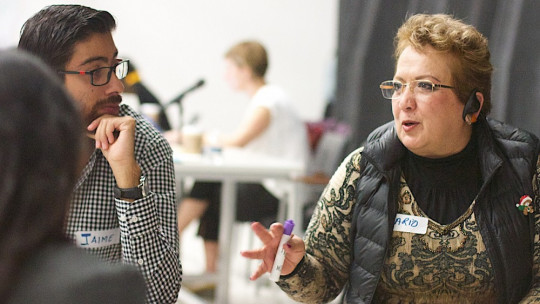
The fear of talking to people It is one of those anxiety-based problems that causes the most problems for a large part of the population whose lifestyle requires frequent interaction with others.
This is an inconvenience that is reflected in everyday life, since almost any conversation with someone relatively little known, no matter how mundane, is prone to leading to nerve problems.
However, recognizing the existence of a problem of these characteristics does not imply knowing how to solve it. For this reason, in some cases it is necessary to go to psychotherapy, although in others it is enough to learn certain emotional management strategies and apply them in a systematic and disciplined way during day to day life. In other words, There are ways to overcome the fear of talking to people, and these can be learned self-taught or with professional help.
To achieve this, there are no magic recipes that will make discomfort disappear overnight, but there are techniques that allow you to structure learning aimed at overcoming the fear of talking to people. Below we will see what are the basic guidelines to follow, although no reading can match the result obtained by working with a psychology professional on each specific case.
How to overcome the fear of talking to people?
To better understand the steps to follow when making the nerves when talking to others stop tormenting us, we must first take into account that each dialogue is unique.
What we want to change is the general pattern, which makes the fear of talking to others widespread; but we should not aim to make it impossible feeling afraid or insecure when being in the presence of someone. This idea, which seems so basic, is fundamental, and for this reason it is necessary that throughout the entire process we have to reanalyze everything that is happening to us, so as not to get frustrated and give up.
Taking this into account, let’s see what are the guidelines that shape these tips to stop being afraid of talking to people. To notice the results, apply them in your daily life, and do not expect significant results from the first hours; It usually takes several days to notice the benefits.
1. Work on your self-concept
One of the components that come into play in this type of anxiety problems is self-esteem. Specifically, self-esteem problems. However, this does not have to mean that someone who feels insecure in a dialogue with someone believes that they are worth less than the other, or that they are less skilled in general.
The belief is that there is less conversational value ; that one’s own words do not flow the same nor the content of what is said is not as interesting as in the case of the interlocutor. This idea becomes a self-fulfilling prophecy, since the insecurity it generates causes attention to be divided between what is done and said and the fear of what is done and said. The result leads to sparse or disorganized speech.

Therefore, it is important to focus on the strengths that one has when facing an everyday conversation. To do this, you do not have to focus on experience or the ability to speak fluently with strangers, since it is obvious that at the moment you do not have that quality; but we can look at what makes us capable of contribute interesting content to a conversation.
For example, if you have university studies or have extensive experience in a field of knowledge that you think may be interesting, remembering this and associating it with your identity will help you feel that you are going to interact with people with better equipment. The same can be said if, due to your age, you have a lot of experience in life or if you are a very curious person and you have already asked yourself many questions that others have not even thought of.
2. Look at the conversational floor
The vast majority of conversations don’t have much substance. Learn to stop for a moment and analyze the literal content of what happens in a normal and ordinary dialogue that has nothing to do with, for example, the work context: fillers occupy a large part of the dialogue, phrases aimed at showing respect and interest in the other They serve no other purpose than to express kindness, and in general they do not display great general culture or prodigious intelligence.
This type of minimum level of demand that occurs in conversations, what we could call “conversational floor”. Being above this is practically like rehearsing for a greater challenge that never comes, a kind of simple tutorial on how to interact with others through words. In general, no one wants to spend too much time on every conversation they have throughout the day, so neither should you.
However, if despite being aware of this you notice that you get stuck or blocked, this You should not think that your mental abilities are negligible. This is simply a sign that where at first there seemed to be a sea of differences between you and others, there is only one very fragile barrier: anxiety. When this disappears, everything will be much more fluid.
3. Don’t memorize phrases, question them
Memorizing phrases to use in a conversation is a trap that people often fall into to try to make the fear of talking to people disappear.
It does not work precisely because it adds more cognitively demanding tasks than would occur if they were not taken into account: the simple fact of think about when it is most appropriate to use one of these lines of dialogue It’s already very distracting. It can help if you already have a certain ease in conversations, but not at the beginning.
Instead of using this resource, choose to focus on listening to what the other person is saying and build your participation in the dialogue by reacting to what you find interesting. In this way you obtain a more natural participation from the beginning, just as would happen in a dialogue in which you had no worries, and you would have a way of facing the conversation being clear that you do not have to be the most talkative party, in exchange to make your interventions meaningful.
4. Learn to distance yourself
As we have seen, all conversations They have a strongly conventional and predictable side. On many occasions, what someone says in 5 or 6 interventions can already be predicted from their first intervention, and everything that comes after is clarifications. In the same way, there are also phrases that serve to imply that you are listening, that you agree, etc. A real dialogue is very different from what would happen in most novels, or in films like Tarantino’s.
Being clear about this, and observing it, allows us to stay above this type of interactions, and see them as if they were almost a theatrical performance in which there is little content, and very scattered throughout the sentences. This will serve to make some of the tension go away. In the same way that you understand why each person uses these seemingly irrelevant components despite contributing little, you will also do so without complexes as the fear goes away.








